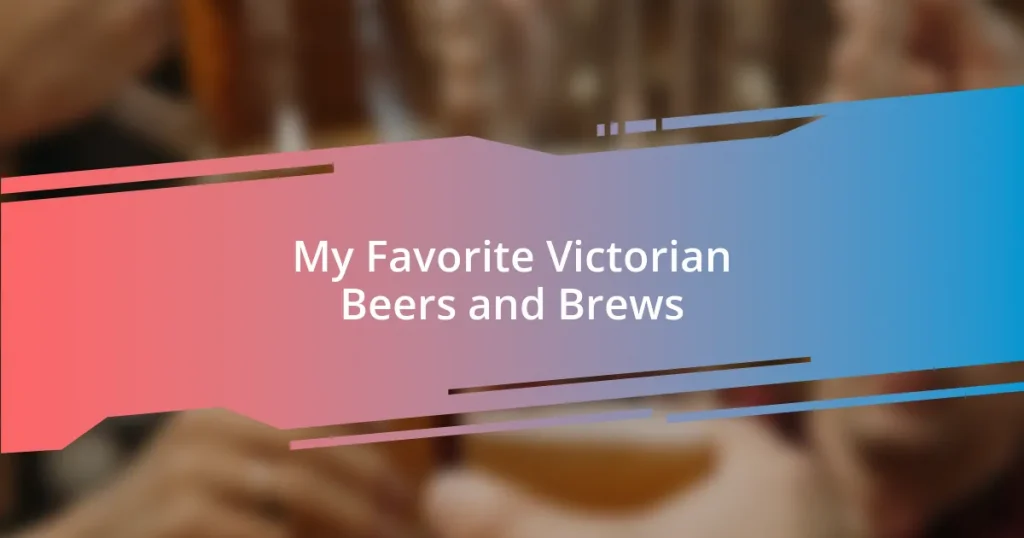Key takeaways:
- Victorian beers reflect a rich brewing heritage characterized by innovation and diverse styles, ranging from porters to pale ales.
- The Industrial Revolution transformed brewing practices, enhancing production consistency and flavor profiles with new ingredients.
- Notable breweries like Carlton and United Breweries and Phoenix Brewery contribute significantly to the craft beer scene by blending traditional methods with modern creativity.
- Food pairings with Victorian beers can enhance the drinking experience, encouraging memorable moments through flavorful connections.

Introduction to Victorian Beers
Victorian beers, with their rich brewing heritage, offer a fascinating glimpse into a time when quality and craftsmanship were paramount. I recall my first encounter with a local Victorian brew; the complexity of flavors and aromas took me by surprise, making me wonder how I had overlooked such a historical treasure in my beer journey. Isn’t it incredible how much a pint can tell us about the era it comes from?
The Victorian era was a period of experimentation, leading to a remarkable variety of styles that still resonate today. From hearty porters to refreshing pale ales, these beers tell the story of innovation amidst social and technological changes. I often find myself thinking about the artisans behind these recipes, pouring their hearts into each batch—do you feel that passion in your favorite brews too?
As we dive deeper into the world of Victorian beers, it’s essential to appreciate their unique place in today’s craft beer landscape. There’s something special about sipping a brew that has roots entwined with history, connecting us to bygone traditions. Whether you’re a seasoned enthusiast or just starting, exploring these beers is like embarking on a flavorful time travel—each sip unfolds a new chapter waiting to be discovered.

History of Victorian Brewing
The history of Victorian brewing is a tapestry woven with innovation and tradition. The Industrial Revolution played a significant role in transforming brewing practices, as the introduction of steam power and refrigeration allowed for more consistent production. I personally find it fascinating to think about how these advancements not only shaped the flavors we enjoy today but also the very culture surrounding beer in that era.
- The formation of brewing partnerships and local breweries increased competition, leading to an explosion of styles.
- The introduction of hops and malt varieties enriched flavor profiles, pushing the boundaries of brewing techniques.
- Beer was an essential part of daily life during the Victorian era, consumed by people from all walks of life.
- The rise of the temperance movement created a complex relationship between alcohol and society, influencing brewing trends.
Reflecting on my experiences tasting some of these historic ales, I can’t help but feel a connection to the past. During one visit to a local brewery, I could almost hear the echoes of laughter and camaraderie that must have filled Victorian pubs, making each sip even more meaningful. It’s this deep-rooted sense of community around Victorian brewing that captivates me, encouraging exploration of both familiar and new flavors from that marvelous time.

Popular Victorian Beer Styles
Popular Victorian Beer Styles reveal the depth and diversity that flourished during this remarkable period. One of my favorites has to be the Porter, a rich and dark beer that embodies the heartiness of Victorian pubs. I remember ordering a classic porter on a chilly afternoon, and the cozy embrace of its roasted malt flavor seemed to wrap around me like a warm blanket. It’s the kind of beer that tells a story with each sip, perfectly paired with hearty dishes or savored on its own.
Another captivating style is the Pale Ale, which marked a shift towards lighter, hoppier brews in the brewing landscape. I once attended a craft beer festival where I stumbled upon a Victorian-style pale ale, and I was struck by its vibrant citrus notes and refreshing finish. It immediately transported me back to a summer gathering in a sun-drenched garden, evoking laughter and the aroma of blooming flowers. Every time I savor a pale ale, I feel that joy blooming again.
Then there’s the fascinating Mild Ale, a lesser-known style that deserves a spotlight. I recall a cozy night at a local brewery where I tried my first mild ale, and it left a lasting impression. With its low alcohol content and gentle sweetness, it felt like a smooth conversation with an old friend. Mild ales may not be as popular today, but their historical significance and flavor profile give them a unique charm that makes them worth exploring.
| Beer Style | Description |
|---|---|
| Porter | A dark beer with roasted malt flavors, rich and hearty. |
| Pale Ale | A light, hoppy beer with vibrant citrus notes. |
| Mild Ale | A low-alcohol beer with a gentle sweetness, smooth and approachable. |

Notable Victorian Breweries
The Victorian brewing scene boasts many noteworthy breweries, each with its own story and impact. Take, for instance, the iconic Carlton and United Breweries (CUB). I vividly remember visiting their historic site, which feels like stepping back in time. The atmosphere was buzzing, filled with the aroma of brewing hops and malt—an experience that truly captured the essence of Victorian craftsmanship.
Another exceptional brewery is Phoenix Brewery, known for its commitment to traditional brewing methods. I can’t help but think about the pride that brewers like those at Phoenix must feel when crafting their ales, keeping age-old recipes alive. One sip of their signature beer took me on a journey through rich, bold flavors, and I found myself pondering—how many people have savored this same brew over the decades, each experiencing a slice of history with every glass?
Lastly, I can’t overlook the influence of the Mountain Goat Beer. This brewery has an interesting twist—while it maintains a strong connection to traditional brewing, they also embrace modern creativity. During a visit to their local taproom, I was amazed by how they infused fresh ingredients into classic beer styles. It made me wonder: could this blend of tradition and innovation be the key to keeping the spirit of Victorian brewing alive today? Each brewery tells its own tale, and I believe they all contribute to the vibrant tapestry of Victorian beer culture.

Pairing Victorian Beers with Food
Pairing Victorian beers with food is an exciting adventure that can enhance both the flavors of the dish and the beer itself. When I indulge in a rich porter, I can’t resist complementing it with a savory beef stew. The deep, roasted malt notes of the porter harmonize beautifully with the rich flavors of the meat, creating a comforting meal that feels like a warm hug on a chilly evening. Have you ever experienced that delightful contrast between a bold drink and hearty dish? It’s a connection that makes every bite more special.
On the other hand, pale ales bring a refreshing lightness, making them perfect for pairing with lighter fare. I once hosted a summer picnic where I served a fruity pale ale alongside grilled shrimp skewers. The citrus notes from the beer danced with the smoky char of the shrimp, creating a vibrant interplay of flavors that had everyone going back for seconds. It struck me how the right pairing can transform a simple meal into a memorable occasion. Isn’t it fascinating how a beverage can elevate everyday dishes?
Mild ales, with their gentle sweetness, offer a unique opportunity for pairing as well. I remember a game night with friends when we enjoyed mild ales alongside a spread of soft cheeses and crusty bread. The creaminess of the cheese balanced perfectly with the smooth, mellow character of the ale, and it reminded me of cozy gatherings filled with laughter. Such pairings prompt a question: how do our drink choices affect our memories of food experiences? In my case, each sip took me further down memory lane, reminding me of the joy that comes from sharing good food and drink.

Tasting Notes for Victorian Brews
The tasting notes for Victorian brews tell a story of tradition and innovation, each sip capturing the essence of its time. I recall sampling a rich stout from a Victorian brewery, where deep chocolate and coffee notes enveloped my palate, mingling with a hint of smoke that lingered deliciously. It made me reflect—how does the historical context of a brew shape its flavor profile?
Exploring the hoppy bitterness of an IPA transports me to sun-drenched afternoons in lively beer gardens. The floral and citrus aromas are invigorating, reminiscent of vibrant gardens in bloom. I remember one particular gathering where friends and I paired this hoppy delight with spicy tacos, adding a layer of complexity that had us debating the perfect brew for the next round. Isn’t it incredible how flavors can spark such lively discussions?
Then there’s the complex character of a well-crafted amber ale, with its caramel sweetness teasing on the tongue. I can still picture the first time I took a sip—it was at a local festival, where the warm sun danced through the trees, creating a comfortable intimacy. The smooth, toasty flavors felt like comfort in a glass, and I couldn’t help but ponder: what emotional connections do we forge with our favorite brews? For me, that day became forever linked to laughter and memorable conversations under the sky.

Crafting Your Own Victorian Beer
Crafting your own Victorian beer is a rewarding journey that allows you to connect with a rich tradition. When I first tried brewing a classic English mild ale, I was amazed at how the aromas filled my kitchen. The gentle sweetness and subtle caramel notes were a testament to patience and the quality of ingredients. Have you ever spent hours perfecting a recipe, only to savor the rewarding results?
As I meticulously measured my grains, I noticed that brewing is an art form influenced by personal choices. Choosing specialty malts, like crystal or chocolate, can genuinely transform the beer’s character. I remember the moment I added a touch of English hops; the earthy and floral notes blossomed, creating a balance that felt both bold and comforting. What does it mean to express one’s creativity through brewing? For me, it became a wonderful outlet, blending science and art.
The fermentation process revealed its own surprises. I once encountered a yeast strain that imparted delightful fruity esters—unexpected but enchanting. Each batch taught me something new, shaping my understanding of how patience plays a vital role in achieving the desired flavor. Doesn’t it feel magical when a simple mix of water, malt, hops, and yeast creates something so dynamic and flavorful? It’s like crafting a little piece of history right in your home.















